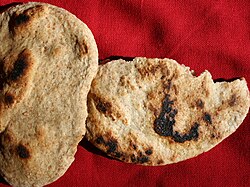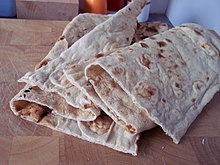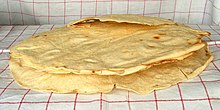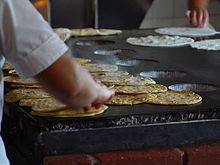Flatbread
 Homemade flatbread | |
| Type | Bread |
|---|---|
| Main ingredients | Flour, water, salt |
This article needs additional citations for verification. (August 2011) |
A flatbread is a simple bread made with flour, water, and salt and then thoroughly rolled into flattened dough. Many flatbreads are unleavened — made without yeast or sourdough culture — although some flatbread is made with yeast, such as pita bread.
There are many other optional ingredients that flatbreads may contain, such as curry powder, diced jalapeños, chili powder, or black pepper. Olive oil or sesame oil may be added as well. Flatbreads can range from one millimeter to a few centimeters thick.
History
Flatbread was already known in Ancient Egypt and Sumer[when?]. In ancient Mesopotamia (modern day Iraq) the Sumerians discovered that edible grains could be mashed into a paste and then baked/hardened into a flatbread.
Religious significance


The term unleavened bread can also refer to breads which are not prepared with leavening agents. These flatbreads hold special religious significance to adherents of Judaism and Christianity. Jews consume unleavened breads such as matzo during Passover.
Unleavened bread is used in the Western Christian liturgy when celebrating the Eucharist. On the other hand, most Eastern Churches explicitly forbid the use of unleavened bread (Greek: azymes) for Eucharist as pertaining to the Old Testament and allow only for bread with yeast, as a symbol of the New Covenant in Christ's blood. Indeed, this was one of the three points of contention that are, in traditional legend, accounted as those that brought about the Great Schism between Eastern and Western churches (the others being Petrine supremacy and the filioque in the Niceno-Constantinopolitan Creed).[1]
Canon Law of the Latin Rite of the Roman Catholic Church mandates the use of unleavened bread for the Host, and unleavened wafers for the communion of the faithful. The more liturgical Protestant churches tend to follow the Latin Catholic practice, whereas others use either unleavened wafers or ordinary bread, depending on the traditions of their particular denomination or local usage.
Regional varieties
Europe, Central & West Asia



- Afghan bread or "Nan" (Afghanistan)
- Lavash or Yukha bread (Azerbaijan)
- Barbari bread (Persia)
- Bazlama (Turkey): made from wheat flour, drinking water, table salt
- Bolanee (Stuffed flatbread) (Afghanistan): a vegetarian flat-bread dish
- Flammkuchen / Tarte flambée (Alsace): thin bread dough rolled out in a circle or a rectangle and covered with onions and bacon
- Flatbrød (Norway): barley flour, salt, and water
- Flatkaka (Iceland): rye flatbread
- Focaccia (Italy)
- Ftira (Malta)
- Gözleme (Turkey): folded over a savory filling and fried on a griddle
- Hoggan (Cornwall): made from barley flour containing pieces of green pork and potato
- Lángos (Hungary)
- Lavash (Armenia)
- Matnakash (Armenia)
- Obi Non (Afghanistan and Uzbekistan)
- Opłatek (Poland)
- Pane carasau (Sardinia)
- Piadina (Italy): white flour, lard (or olive oil), salt and water
- Pide (Turkey)
- Pita (Greece)
- Pită / Lipie (Romania)
- Pizza (Italy)
- Podpłomyk (Poland)
- Rieska (Finland)
- Sacramental bread
- Sangak (Persia)
- Sheermal (Persia and Indian subcontinent)
- Shoti (Georgia)
- Somun and Lepina (Bosnia and Herzegovina)
- Taftoon Bread (Persia)
- Tonis Puri (Georgia)
- Torta (Spain)
- Torta de Gazpacho (Spain)
- Tunnbröd (Sweden): any combination of wheat, barley and rye
- Yufka (Turkey): wheat flour, water and table salt
Middle East and Africa


- Aish Merahrah (Egypt): made with 5 -10% ground fenugreek seeds and maize
- Gurrasa (Sudan)
- Harsha (Morocco): fried buttery bread made of semolina
- Injera (Ethiopia, Eritrea): teff flour and water
- Khubz (Arabian Peninsula)
- Laxoox (Somalia)
- Malooga (Yemen): water, yeast, salt and flour
- Mandazi (East Africa)
- Markook (Levant)
- Matzo (Jewish): white plain flour and water
- Ngome (Mali): millet, water and vegetable oil
- Pita (Eastern Mediterranean and Middle East)
South and East Asia


- Bhakri (India): made with water and typically millet flour
- Bhatura (India): typically made with white flour, yogurt, ghee or oil, and yeast
- Bindaeddeok (Korea): made from mung bean flour {this is a pancake, not a flatbread}
- Bing (China)
- Chapati (India, Pakistan): made from atta flour (whole grain durum wheat), water, and salt
- Green onion pancake (China): made with oil and minced scallions (green onions)
- Paratha (India, Sri Lanka, Nepal)
- Khanom buang (Thailand): rice flour
- Laobing (China)
- Luchi (East India and Bangladesh): fine maida flour with water and a spoonful of ghee
- Naan (Central and South Asia): leavened with yeast, unlike Roti bread
- Pol roti (Sri Lanka): made from scraped coconut and wheat or kurakkan flour, with green chillis and onion
- Puri (India, Pakistan, Nepal): prepared from dough of atta and salt
- Roast paan (Sri Lanka): bread mixture baked in a flat mold, producing, literally, a 'flat' bread
- Roti (Central and South Asia)
- Roti canai (Malaysia and Indonesia)
- Sanchuisanda: baked in ashes[2]
Americas

- Arepa (Colombia, Venezuela): flat, unleavened patty made of cornmeal
- Bammy (Jamaica): made from grated cassava root or cassava root flour and salt
- Beiju (Brazil): made from tapioca
- Casabe (South America, Caribbean): made from bitter cassava root
- Casava (Haiti): made from manioc (cassava root)
- Flatbread (North America): made from maize flour in traditional style of early Native Americans; now topped with ground beef, vegetables, beans and cheese
- Frybread (United States)
- Pan de Semita (Mexico)
- Tortilla (Mexico, Central and South America)
- Tortilla de Rescoldo (Chile): wheat flour based bread, traditionally baked in the coals of a campfire
References
- ^ Ware, Timothy (1964), The Orthodox Church, London: Penguin Books, p. 66, ISBN 0-14-020592-6
- ^ Sanchuisanda is described in "Peoples of China's Far Provinces", by Wong How-Man, National Geographic, March 1984.



